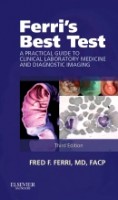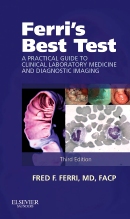 Editor: Fred F. Ferri, MD, FACP
Editor: Fred F. Ferri, MD, FACP
Publisher: Elsevier Saunders – 404 pages
Book Review by: Nano Khilnani
This book has been developed as a manual for medical students, interns, residents, practicing physicians, and other health care professionals who deal with laboratory testing of specimens and imaging for diagnostic purposes.
Aware of today’s healthcare imperatives in reducing costs, everyone involved is faced with the question: which tests to order and which not to? This book answers that question for you in each instance. It is divided into three main sections: clinical laboratory testing, diagnostic imaging, and diagnostic algorithms.
Section I entitled Diagnostic Imaging covers a range of common diagnostic imaging tests (12 groups of tests marked A to L – see list below). Each test is labeled in relation to these five approaches: Indications, Strengths, Weaknesses, Comments, and Cost.
The 12 groups of diagnostic imaging tests are:
- Abdominal and gastrointestinal (GI) imaging (23 tests)
- Breast imaging (3 tests)
- Cardiac imaging (7 tests)
- Chest imaging (3 tests)
- Endocrine imaging (4 tests)
- Genitourinary imaging (9 tests)
- Musculoskeletal and spinal cord imaging (11 tests)
- Neuro-imaging of brain (2 tests)
- Positron emission tomography or PET (1 test)
- Single-photon emission computed tomography or SPECT (1 test)
- Vascular imaging (13 tests)
- Oncology (2 tests)
So for example, Mammography – a common test and the first of the breast imaging tests – is labeled with these Indications: screening for breast cancer; American Cancer Society guidelines recommend a baseline mammogram for women aged 35 to 40 and yearly mammograms after age 40. For women younger than 30, mammography generally not indicated unless there’s a positive family history of breast cancer at a very early age. This test includes evaluation of breast mass and tenderness.
The Strengths labeled for this test are that it is inexpensive and readily available. The
The Weaknesses are that this test misses 15 to 20 percent of breast neoplasms (cancer tissues); it can be painful for the patient; and it gives poor identification of non-palpable intraductal papillomas.
Many women have breast symptoms such as swelling and tenderness, nodularity, pain, palpable lumps, nipple discharge, or breast infections and inflammation. Fortunately mammography, relatively few have breast cancer. Physicians must therefore distinguish benign breast conditions from malignant ones, when to treat them or in what instances to refer the patient to a specialist.
The other weakness is that residue on breasts from powders, deodorants, or perfumes may interfere with diagnosis of lesions.
Four different Comments have been written about Mammography. We urge the student or specialist in women’s medicine to read them. As for the Cost of this test, only a single $ sign has been placed, which means it is relatively inexpensive. The cost of tests range from $ to $$$$$$ (one to six $ signs, meaning inexpensive to very expensive).
Section II entitled Laboratory Values and Interpretation of Results describes over 300 laboratory tests. Each test is approached with the following format:
- Laboratory test
- Normal range in adult patients
- Common abnormalities
- Causes of an abnormal result
A common test in this list is the Red Blood Cell Count test. This test shows that the normal range of red blood cells in males is 4.3 to 5.9 x 106 /mm3 and for females it is 3.5 to 5 x 106 /mm3. The red blood cell count is above this range for people who suffer from: cardiovascular disease, dehydration, renal cell carcinoma, or stress; and those at high altitude and several other conditions.
Those with lower than normal range of blood cell count are people with anemia, those who suffer from chronic renal (kidney) failure, hemolysis, hemorrhage, or marrow production failure.
Section III entitled Diseases and Disorders deals with the diagnostic modalities (imaging and laboratory tests) and algorithms of over 140 common diseases and disorders.
This is a very popular handbook among medical and health professionals simply because it is very useful: a quick reference work to a large number of diseases and disorders, and the tests for their diagnosis. It is one among a series of several medical guides developed by the author Dr. Fred F. Ferri.







